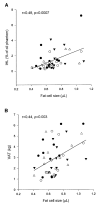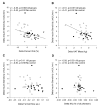Effect of calorie restriction with or without exercise on insulin sensitivity, beta-cell function, fat cell size, and ectopic lipid in overweight subjects
- PMID: 16732018
- PMCID: PMC2677812
- DOI: 10.2337/dc05-2565
Effect of calorie restriction with or without exercise on insulin sensitivity, beta-cell function, fat cell size, and ectopic lipid in overweight subjects
Abstract
Objective: The purpose of this article was to determine the relationships among total body fat, visceral adipose tissue (VAT), fat cell size (FCS), ectopic fat deposition in liver (intrahepatic lipid [IHL]) and muscle (intramyocellular lipid [IMCL]), and insulin sensitivity index (S(i)) in healthy overweight, glucose-tolerant subjects and the effects of calorie restriction by diet alone or in conjunction with exercise on these variables.
Research design and methods: Forty-eight overweight volunteers were randomly assigned to four groups: control (100% of energy requirements), 25% calorie restriction (CR), 12.5% calorie restriction +12.5% energy expenditure through structured exercise (CREX), or 15% weight loss by a low-calorie diet followed by weight maintenance for 6 months (LCD). Weight, percent body fat, VAT, IMCL, IHL, FCS, and S(i) were assessed at baseline and month 6.
Results: At baseline, FCS was related to VAT and IHL (P < 0.05) but not to IMCL. FCS was also the strongest determinant of S(i) (P < 0.01). Weight loss at month 6 was 1 +/- 1% (control, mean +/- SE), 10 +/- 1% (CR), 10 +/- 1% (CREX), and 14 +/- 1% (LCD). VAT, FCS, percent body fat, and IHL were reduced in the three intervention groups (P < 0.01), but IMCL was unchanged. S(i) was increased at month 6 (P = 0.05) in the CREX (37 +/- 18%) and LCD (70 +/- 34%) groups (P < 0.05) and tended to increase in the CR group (40 +/- 20%, P = 0.08). Together the improvements in S(i) were related to loss in weight, fat mass, and VAT, but not IHL, IMCL, or FCS.
Conclusions: Large adipocytes lead to lipid deposition in visceral and hepatic tissues, promoting insulin resistance. Calorie restriction by diet alone or with exercise reverses this trend.
Figures


References
-
- Forsey RJ, Thompson JM, Ernerudh J, Hurst TL, Strindhall J, Johansson B, Nilsson BO, Wikby A. Plasma cytokine profiles in elderly humans. Mech Ageing Dev. 2003;124:487–493. - PubMed
-
- Matsumoto K, Sera Y, Abe Y, Ueki Y, Tominaga T, Miyake S. Inflammation and insulin resistance are independently related to all-cause of death and cardiovascular events in Japanese patients with type 2 diabetes mellitus. Atherosclerosis. 2003;169:317–321. - PubMed
-
- Utzschneider KM, Carr DB, Hull RL, Kodama K, Shofer JB, Retzlaff BM, Knopp RH, Kahn SE. Impact of intra-abdominal fat and age on insulin sensitivity and β-cell function. Diabetes. 2004;53:2867–2872. - PubMed
-
- Kelley DE, Thaete FL, Troost F, Huwe T, Goodpaster BH. Subdivisions of subcutaneous abdominal adipose tissue and insulin resistance. Am J Physiol. 2000;278:E941–E948. - PubMed
-
- Weyer C, Foley JE, Bogardus C, Tataranni PA, Pratley RE. Enlarged subcutaneous abdominal adipocyte size, but not obesity itself, predicts type II diabetes independent of insulin resistance. Diabetologia. 2000;43:1498–1506. - PubMed

